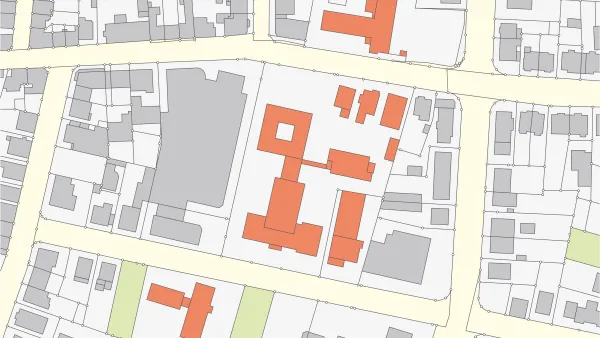A few years ago, someone asked me the following question (loosely paraphrased) on a listserv: “Since the most tradition-minded* religious Jews are required by Jewish law to walk to synagogue on Sabbaths and holy days (and thus presumably prize walkability) why aren’t they a major market for new urbanist developments?” At the time, I didn’t have a coherent answer. But now that I know more about both traditional Jews and new urbanism, I do.
A few years ago, someone asked me the following question (loosely paraphrased) on a listserv: "Since the most tradition-minded* religious Jews are required by Jewish law to walk to synagogue on Sabbaths and holy days (and thus presumably prize walkability) why aren't they a major market for new urbanist developments?" At the time, I didn't have a coherent answer. But now that I know more about both traditional Jews and new urbanism, I do.
A new development (new urbanist or otherwise) far from an existing congregation may have difficulty attracting the most tradition-minded Jews, for the simple reason that most such Jews would rather live near a preexisting congregation than move elsewhere, pray at home for a few years, and wait for enough people to follow them for a congregation to emerge. (Of course, it does happen now and then).
To be sure, a congregation does occasionally move en masse- but given that congregants have investments in existing housing, this rarely happens (except perhaps in times of rapid neighborhood transition, such as the third quarter of the 20th century when many urban neighborhoods switched from all-white to all-black over a very short period of time).
Of course, an infill new urbanist development could be located near an existing congregation. But infill developers will not always be able to get large numbers of observant Jewish customers. Here's why: new housing usually tends to be more expensive than old housing. But the most traditional Jews tend to have less money to spend on housing than the most affluent buyers, for two reasons.
First, among Jews (as among Christians) the most religiously traditional people tend to have the largest families. Lots of mouths to feed mean less money to spend on housing, which is why Orthodox Jewish communities (where the majority of congregants usually walk to synagogue) are rarely in a city's most expensive neighborhoods, except in large cities with lots of Orthodox communities. Second, large families usually need more space than small families, which means that if a large, religiously traditional Jewish family has extra housing dollars to spend, it will spend those dollars on extra space rather than on a newer house.
As a result of these factors, the most observant Jews tend to be disproportionately attracted to older, not-too-expensive inner suburbs: older because (as noted above) any new development will not immediately attract a critical mass of religious Jews, inner suburban because inner suburbs usually have cheaper housing and more space than downtown neighborhoods. For example, in Atlanta the center of Orthodox Jewry is Toco Hills, a 1950s suburb just past the city limits of Atlanta.** Indeed, I would posit that religious Jews are to 1950s suburbs what gays and artists are to intown neighborhoods: a group disproportionately attracted to neighborhoods that might deteriorate in the absence of that group's presence.
*Usually Orthodox, but not always: not all Jews belonging to Orthodox congregations have taken on this religious obligation, and a minority of non-Orthodox Jews have done so.
**Although there are Orthodox congregations outside Toco Hills, my sense is that their members tend to be less religiously strict than those of the Toco Hills congregations. Similarly, in some other cities where there are multiple Orthodox communities, the strictest tend to be in middle-aged suburbs or "outer borough" city neighborhoods rather than in downtown or the newest suburbs. For example, in Philadelphia, the most strict Orthodox Jews tend to be in inner-suburban Northeastern Philadelphia, while downtown Philadelphia's Orthodox Jews tend to be more moderate.

Analysis: Cybertruck Fatality Rate Far Exceeds That of Ford Pinto
The Tesla Cybertruck was recalled seven times last year.

National Parks Layoffs Will Cause Communities to Lose Billions
Thousands of essential park workers were laid off this week, just before the busy spring break season.

Retro-silient?: America’s First “Eco-burb,” The Woodlands Turns 50
A master-planned community north of Houston offers lessons on green infrastructure and resilient design, but falls short of its founder’s lofty affordability and walkability goals.

Test News Post 1
This is a summary

Analysis: Cybertruck Fatality Rate Far Exceeds That of Ford Pinto
The Tesla Cybertruck was recalled seven times last year.

Test News Headline 46
Test for the image on the front page.
Urban Design for Planners 1: Software Tools
This six-course series explores essential urban design concepts using open source software and equips planners with the tools they need to participate fully in the urban design process.
Planning for Universal Design
Learn the tools for implementing Universal Design in planning regulations.
EMC Planning Group, Inc.
Planetizen
Planetizen
Mpact (formerly Rail~Volution)
Great Falls Development Authority, Inc.
HUDs Office of Policy Development and Research
NYU Wagner Graduate School of Public Service





























